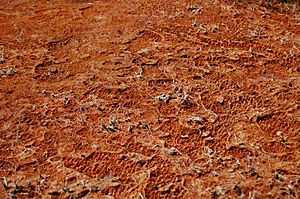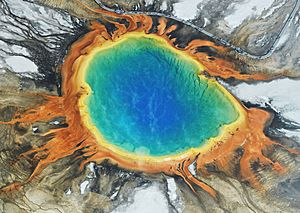Thermophile facts for kids
A thermophile is a tiny living thing, like a type of bacteria or archaea, that loves to live in really hot places. Think of them as "heat-loving" organisms! They can grow and thrive in temperatures between 41 and 122 degrees Celsius (that's 106 to 252 degrees Fahrenheit!). Many thermophiles are a special kind of single-celled organism called archaea, but some are also bacteria or even fungi. Scientists think that some of the very first bacteria on Earth might have been thermophiles.
You can find thermophiles in many naturally heated spots around the Earth. They live in hot springs, like the famous ones in Yellowstone National Park, and deep under the ocean near hydrothermal vents (which are like underwater geysers). They also live in places where plants are decaying, such as peat bogs and compost piles, because these places can get quite warm.
What makes thermophiles so special is their ability to survive and grow in temperatures that would harm or even kill most other living things. Their enzymes, which are like tiny machines inside their cells, are built to work perfectly in high heat. Some of these enzymes are super useful in molecular biology, like the Taq polymerase enzyme used in a process called PCR, which helps scientists make many copies of DNA. The word "thermophile" comes from Greek words meaning "heat" and "love."
Contents
How Thermophiles Are Classified
Scientists group thermophiles in different ways, often based on how hot their favorite living temperature is.
Based on Temperature Preference
- Simple thermophiles: These organisms like temperatures between 50 and 64 degrees Celsius (122-147.2 degrees Fahrenheit).
- Extreme thermophiles: They prefer even hotter conditions, from 65 to 79 degrees Celsius (149-174.2 degrees Fahrenheit).
- Hyperthermophiles: These are the ultimate heat-lovers! They thrive at 80 degrees Celsius (176 degrees Fahrenheit) and even higher.
Based on Their Need for Heat
- Facultative thermophiles: Also called moderate thermophiles, these can live in hot places, but they can also survive in cooler temperatures (below 50 degrees Celsius).
- Obligate thermophiles: These are the true heat-seekers! They absolutely need high temperatures to grow and survive.
- Hyperthermophiles: These are a very extreme type of thermophile that needs temperatures above 80 degrees Celsius to live.

Many hyperthermophilic archaea need a chemical element called sulfur to grow. Some of them are anaerobes, meaning they don't need oxygen. Instead, they use sulfur in a process similar to breathing to get energy. Some can even eat sulfur to create sulfuric acid as their energy source. This means they can also live in very acidic places, making them both heat-loving and acid-loving! You often find these organisms in hot, sulfur-rich areas linked to volcanism, like hot springs, geysers, and fumaroles. In places like Yellowstone National Park, you can see different types of these tiny organisms living in different zones, depending on how hot the water is. They often have bright colors because they contain special pigments that help them get energy from light, similar to how plants do photosynthesis.
Fungal Thermophiles
Fungi are a type of organism in the Eukarya kingdom (which includes plants, animals, and fungi). Among them, only certain fungi can survive in temperatures between 50 and 60 degrees Celsius. These heat-loving fungi are very important for biotechnology. They can produce special enzymes that work well in high temperatures, which are useful for breaking down plant materials in industries.
See also
 In Spanish: Termófilo para niños
In Spanish: Termófilo para niños


